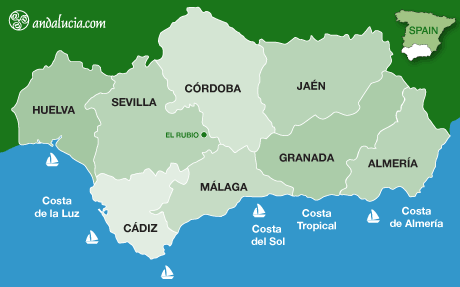EL RUBIO
by Saskia Mier
El Rubio is positioned between Estepa and Écija and during the Roman era, there was a road connecting the towns that was also used to monitor traffic. It has about 3,500 inhabitants.
HISTORY
The origins of El Rubio are not very well known and it is suspected that its name could come from a Roman settlement, although it seems clearer that it comes from a surname of Cortijo El Rubio that appeared in repopulations conquered from the Moors.
El Rubio was given to an Order of Cavalry, The Order of Santiago that today appears in the shield, to which also was granted privileges on territories of Estepa. The history of El Rubio was marked by a slow growth that would entail a series of disputes with Osuna regarding its independence.
At the beginning of the twentieth century El Rubio saw its population being reduced by the successive migrations and the lack of work in the village. Today, it is experiencing a revitalisation thanks to the appearance of new industries and new communications with the region.
THINGS TO SEE
Iglesia Nuestra Señora del Rosario
The church is of Mudéjar style, around the seventeenth century, and many reforms have been carried out later in the years, specifically throughout the eighteenth century. It contains many images dating to the seventeenth and eighteenth centuries. Located on Calle Antonio Machado.
Casa de los Torres
The house once belonged to the Sevillian architect, Aníbal González Álvarez-Ossorio in 1929. Currently, it has belonged to the 'de los Torres' family since 1978 and is one of the major exponents of Andalusian regionalism of the region of Osuna and Estepa. Located on Calle Cervantes.
THINGS TO SEE OUTSIDE THE VILLAGE
Ermita del Cerro de la Cabeza
The chapel is dedicated to the Virgen del Rosario, emblematic patron of El Rubio. In its surroundings is celebrated the well-known and popular pilgrimage. Located on the SE-726.
Yacimientos Arqueológicos
Various archaeological sites have been found in the area, with remnants of Roman villas, sepulchres and alignments of foundations where houses once stood.
Cortijo El Marqués
The Cortijo was once an olive oil mil, but when olive groves were abandoned, it had a negative effect on its conservation. After years dedicated to the cultivation of cereals and pig breeding, its owner has had a keen interest in recovering traditional farming methods. It once belonged to the Marquis of El Rubio and much of the original machinery has been kept by the current owner, forming a small museum for private enjoyment. Although it has undergone a few reformations, it conserves its entity as a mill with its most significant piece; its huge tower. Located on the SE-726.
Torre de Gallape
The tower offers the visitor a formidable appearance despite its ruinous state. It is oriented according to the cardinal points, having its access from the north side, from where many kilometres of the region were controlled. On the door are the corbels of the lookout section that defended it. Inside there are no remains of stairs. The most curious is a few metres to the south of the tower; where there are the remains of what could be two cisterns and also remains of a possible fence. Perhaps they were part of the facilities of the tower, or they may be the remains of a previous fortification. Located northwest of El Rubio, left of Arroyo de Gallape.
NATURAL AREAS
El Rubio has some lovely areas which have been wonderfully preserved for everyone to enjoy. These include Cerro de Calatrava located on Camino del Cementerio and Cerro de la Cabeza which has some beautiful ceramics to observe, located on the SE-726.
GASTRONOMY
Typical dishes in El Rubio include cordero a la brasa (grilled lamb), migas con chorizo y morcilla (bread with chorizo and black pudding), tortilla campera (omlette), espinacas "esparragás" (spinach), salmorejo (cold tomato and garlic soup) and potaje (chickpea and meat stew). Sweet treats include asopaipas, ochíos, piononos and magdalenas.
FESTIVALS
Cabalgata Reyes Magos
Three Kings procession celebrated on the evening of 5 January.
Carnaval
Celebrated in February.
Semana Santa
Holy Week.
Romería de Nuestra Señora del Rosario
Celebrated the first Sunday of May.
Feria y Fiesta de la Patrona Nuestra Señora del Rosario
Celebrated in August.
NEXT PLACES
The next villages to El Rubio are Osuna, Écija and Estepa.
Book your stay in Andalucia Now!
